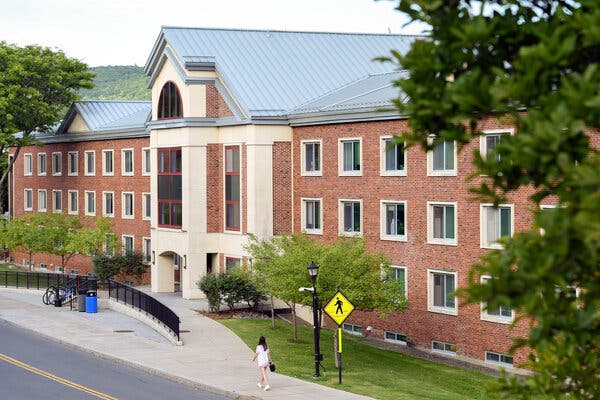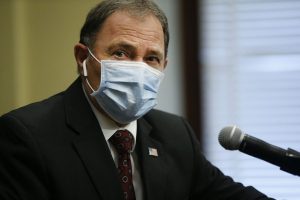As Thanksgiving approaches, millions of Americans are weighing the risk of pandemic travel against the yearning to visit friends and family. But one group seems all but certain to be heading home in large numbers just in time for turkey and holiday gatherings: College students.
Since the start of the fall semester, most universities have planned to end in-person classes before Thanksgiving and require students to finish the term remotely, partly to avoid an expected wave of cold-weather infections. That means that in a couple of weeks, hundreds of thousands of students will be crisscrossing the country by plane, train, bus and car, streaming back to hometowns until the spring semester begins.
So what are colleges and universities doing to reduce the chances that those students might carry the coronavirus with them?
As has been true with so much of the nation’s response to the pandemic, the answer is a patchwork of policies, with a minority of schools mandating that students test negative on coronavirus tests before they can leave campus — and many more offering little more than optional testing and advice.
Indiana University in Bloomington — where dozens of fraternity and sorority houses had to quarantine in September — will open its weekly surveillance testing to all of the 42,000 students living on or near campus. But the testing will be voluntary for most.
Pennsylvania State University — where off-campus parties around the football opener last weekend drew a rebuke from President Eric J. Barron — will offer free exit tests and strongly encourage students to get them, but won’t make them mandatory for the more than 13,500 students in university housing or the tens of thousands off-campus.
“We have found that students are responding well to our voluntary, convenient and free walk-up testing sites,” the university said in a statement.
The University of Michigan — where infections recently spiked so severely that local health officials issued a stay-in-place order — will make exit tests mandatory for some 5,000 undergraduates in university housing, but voluntary for thousands more living off-campus.
At the other end of the spectrum, a smaller number of schools are insisting on exit testing.
New York State’s university system — whose Oneonta campus ceased in-person classes in September after more than 700 students tested positive for the virus — will require “all students using on-campus facilities in any capacity” to test negative for the virus within 10 days of their departure, and to quarantine according to county health rules if they test positive, whether they are on or off-campus. The plan will entail testing about 140,000 students at SUNY’s 64 colleges and universities.
Tulane University in New Orleans will test undergraduates twice in the last week of class, including those living off-campus. Hamilton College in Clinton, N.Y., will require students to show a minimum of two negative Covid-19 tests on the week prior to departure. Those who test positive at Tulane will be offered housing and support and “strongly advised” not to travel, according to a school spokesman, while Hamilton has reserved quarantine rooms at a local hotel and plans to work with local health officials to track down any student who refuses to isolate.
And in Massachusetts, where cases have been surging, Boston University has asked students not to leave campus, period, until Dec. 10, when classes end. “We are saying, ‘Stay here,’ plain and simple,” Kenneth Elmore, the associate provost and dean of students, said.
Epidemiologists recommend that travelers isolate themselves before traveling for at least a week and receive one or more negative coronavirus test within three days of departure. Upon arrival, they should again quarantine until receiving one or more negative test results over three days. Those who do not test should quarantine for 14 days before and after traveling.
Calling universities’ Thanksgiving plans “all over the map,” A. David Paltiel, a professor of health policy and management at the Yale School of Public Health, said colleges should be keeping quarantine dorms open for students who test positive just before Thanksgiving.
“There’s a responsibility not to unleash little ticking time bombs,” said Dr. Paltiel, noting that recently exposed students can feel well and still shed large quantities of the virus. “But this has not yet hit the radar screen of many college administrators.”
The Centers for Disease Control and Prevention has not issued guidance specific to holiday breaks for college students, though it has advised that “travel increases the chance of getting and spreading the virus that causes COVID-19.”
The American College Health Association,’ which represents college health officers, issued public health guidelines last week recommending that schools encourage students to get tested before their Thanksgiving departure, refrain from traveling if they test positive and quarantine for 14 days at home upon arrival. But the association stopped short of calling for mandatory testing.
Gerri Taylor, co-chair of the organization’s Covid-19 task force, said that, while testing is key, many financially strapped colleges cannot afford it.
“I was talking recently to a college in the Northwest, and they literally only had enough testing supplies for sick people,” Ms. Taylor said.
More than a third of the country’s colleges and universities invited students back for the fall with some degree of socially distanced campus housing or face-to-face instruction, according to the College Crisis Initiative and the Chronicle of Higher Education, which have been tracking about 3,000 schools.
The New York Times has documented more than 252,000 coronavirus cases and at least 80 deaths on college campuses since the pandemic began. Most of the deaths involved college employees in the spring. But at least four students — most recently, Bethany Nesbitt, a 20-year-old student at Grace College in Indiana — have died this semester after contracting Covid-19.
The Coronavirus Outbreak ›
Words to Know About Testing
Confused by the terms about coronavirus testing? Let us help:
-
- Antibody: A protein produced by the immune system that can recognize and attach precisely to specific kinds of viruses, bacteria, or other invaders.
- Antibody test/serology test: A test that detects antibodies specific to the coronavirus. Antibodies begin to appear in the blood about a week after the coronavirus has infected the body. Because antibodies take so long to develop, an antibody test can’t reliably diagnose an ongoing infection. But it can identify people who have been exposed to the coronavirus in the past.
- Antigen test: This test detects bits of coronavirus proteins called antigens. Antigen tests are fast, taking as little as five minutes, but are less accurate than tests that detect genetic material from the virus.
- Coronavirus: Any virus that belongs to the Orthocoronavirinae family of viruses. The coronavirus that causes Covid-19 is known as SARS-CoV-2.
- Covid-19: The disease caused by the new coronavirus. The name is short for coronavirus disease 2019.
- Isolation and quarantine: Isolation is the separation of people who know they are sick with a contagious disease from those who are not sick. Quarantine refers to restricting the movement of people who have been exposed to a virus.
- Nasopharyngeal swab: A long, flexible stick, tipped with a soft swab, that is inserted deep into the nose to get samples from the space where the nasal cavity meets the throat. Samples for coronavirus tests can also be collected with swabs that do not go as deep into the nose — sometimes called nasal swabs — or oral or throat swabs.
- Polymerase Chain Reaction (PCR): Scientists use PCR to make millions of copies of genetic material in a sample. Tests that use PCR enable researchers to detect the coronavirus even when it is scarce.
- Viral load: The amount of virus in a person’s body. In people infected by the coronavirus, the viral load may peak before they start to show symptoms, if symptoms appear at all.
Nationally, the virus has continued to smash records, with more than 100,000 new cases recorded on Wednesday alone. People infected with the coronavirus are most contagious in the days before they display symptoms, and up to 40 percent of infected people are asymptomatic, according to C.D.C. research. That’s why epidemiologists cite fast, widespread and frequent testing of people with and without symptoms as the best way to pinpoint and contain outbreaks.
That level of testing has posed an immense financial hurdle for the many colleges that have had to cut budgets, lay off or furlough faculty and spend millions on health measures during the pandemic.
Some schools — mostly small, rural schools with limited sports programs and Greek life — mandated frequent and widespread testing and contact tracing, sent scofflaws home and managed, often at significant cost, to allow students to keep attending face-to-face classes and living in dorms. Others have opted for less aggressive — and generally less successful — measures, such as testing only volunteers or people with symptoms.
Colby College, which has required twice-a-week testing and largely kept the virus at bay throughout the semester, will test its roughly 2,000 students on Monday, Tuesday and Wednesday of Thanksgiving week. If they test positive, the college will house and feed students for two weeks in quarantine dorms or work with Maine health authorities to work out alternate plans for isolation.
It will also offer a free flu shot before sending students home with take-home finals and detailed instructions on health safety measures. They will be required to be tested before they return to campus early next year, and will be immediately tested upon their arrival at school — and then again two days later, remaining in quarantine until they are clear.
Indiana University has been testing a sampling of its faculty, staff and students each week to identify and contain outbreaks. After starting the semester with nearly 6 percent of those tests returning positive, the Bloomington campus is now about 1 percent, considered very low, Chuck Carney, a university spokesman, said. The university has recorded more than 3,100 cases since the beginning of the pandemic.
But while the university is offering testing to all students just before Thanksgiving, most students will not be required to take one.
“I would rather give people as much information as possible and trust that they’re going to make a decision that’s best for them and their families instead of putting down rules that could be broken,” said Erika Cheng, the university’s deputy director for mitigation testing. “We can’t force anybody to do anything.”
Sheldon Jacobson, a risk assessment specialist and professor of computer science at the University of Illinois who has studied the pandemic’s impact on campuses, said many colleges are getting better at containing outbreaks and reducing infection levels, though some large ones continue to struggle.
“Most of the students will be going to communities with higher infection rates than where they’re leaving,” Dr. Jacobson said.
Even so, Dr. Paltiel said testing should be mandatory. Voluntary exit tests, he said, merely bring out “the worried well and the symptomatic.” And not testing and quarantining again when students get home ignores the real possibility that they could be infected while traveling. “The last thing you want to do is put a whole bunch of students on planes, trains and automobiles, with many of them potentially exposed but not yet exhibiting symptoms, and ship them home to mom and dad,” he said.
Julie Halpert contributed reporting.



















